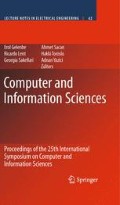Abstract
Applications of scientific workflows are going to be more widespread and important to our living and lives. The intrinsic characteristics of scientific workflows are data- and computing-intensive, heterogeneous data representation and distributed execution environments. Scientists use different equipment to re- trieve source data by monitoring objects and then store or process on many differ- ent workstations. Actor Petri net Model (APnM) helps develop scientific work- flows effectively and efficiently within collaboration and cooperation work mode. Scientific workflow environments based on APnM can help scientists pay close attention to functional components development, and choose flexible mechanisms on error management, transaction and exception management, and priority pro- cessing. Scientific workflows represented based on APnM can be operated both on design and run time to support trial and error development. From the perspec- tive of software engineering, it is a suitable level of indirection to resolve the development, testing, and simulation complexity of scientific workflows.
Access this chapter
Tax calculation will be finalised at checkout
Purchases are for personal use only
Preview
Unable to display preview. Download preview PDF.
References
A Computer Wanted. http://query.nytimes.com/gst/abstract.html?res=9F07E0D81438E233A25751C0A9639C94639ED7CF, 1892.
Actor Petri net Model. http://sites.google.com/site/dunanshan.
R. Barga and D. Gannon. Scientific versus business workflows. In I. J. Taylor, E. Deelman, D. Gannon, and M. S. Shields, editors, Workflows for e-Science: Scientific Workflows for Grids, pages 9–16. Springer-Verlag, NJ, USA, 2007.
F. Casati, S. Ceri, B. Pernici, and G. Pozzi. Workflow evolution. Data & Knowledge Engineering, 24(3):211–238, 1998.
F. Darema. New software technologies for the development and runtime support of complex applications. International Journal of High Performance Computing Applications, 13(3):180–190, 1999.
E. Deelman. Grids and Clouds: MakingWorkflow ApplicationsWork in Heterogeneous Distributed Environments. International Journal of High Performance Computing Applications, 2009.
N. Du, Q. Li, and Y. Liang. Actor petri net model for scientific workflows: Model, design and system. In Proceedings of the 4nd international conference on Ubiquitous information management and communication, Suwon, Korea, 2010. ACM.
C. Ellis and K. Keddara. ML-DEWS: Modeling language to support dynamic evolution within workflow systems. Computer Supported Cooperative Work (CSCW), 9(3):293–333, 2000. 10.1023/A:1008799125984.
J. Hendler. Communication: Enhanced: Science and the semantic web. Science, 299(5606):520–521, 2003.
J. Hidders, N. Kwasnikowska, J. Sroka, J. Tyszkiewicz, and J. Van den Bussche. DFL: A dataflow language based on petri nets and nested relational calculus. Information Systems, 33(3):261–284, 2008.
Kepler. http://www.kepler-project.org/.
M. Reichert and P. Dadam. ADEPTflex—supporting dynamic changes of workflows without losing control. Journal of Intelligent Information Systems, 10(2):93–129, 1998. 10.1023/A:1008604709862.
R.-Z. Sun and M.-L. Shi. A meta-model supporting dynamic changing workflow. Acta Electronica Sinica, 30(1):2052–2056, 2002.
Taverna. http://taverna.sourceforge.net/.
I. J. Taylor, E. Deelman, D. Gannon, and M. S. Shields, editors. Workflows for e-Science: Scientific Workflows for Grids. Springer-Verlag, NJ, USA, 2007.
Virtual Data Toolkit. http://vdt.cs.wisc.edu/.
L. Wang, Z. Huang, and M. Luo. Supporting dynamic workflow adaptation in a dataflowconstrained workflow net. In NISS ’09: Proceedings of the 2009 International Conference on New Trends in Information and Service Science, pages 1000–1005, Washington, DC, USA, 2009. IEEE Computer Society.
Author information
Authors and Affiliations
Corresponding author
Editor information
Editors and Affiliations
Rights and permissions
Copyright information
© 2011 Springer Science+Business Media B.V.
About this paper
Cite this paper
Du, N., Li, Q., Liang, Y., Zhong, F. (2011). Actor Petri net Model: toward Suitable and Flexible Level Representation of Scientific Workflows. In: Gelenbe, E., Lent, R., Sakellari, G., Sacan, A., Toroslu, H., Yazici, A. (eds) Computer and Information Sciences. Lecture Notes in Electrical Engineering, vol 62. Springer, Dordrecht. https://doi.org/10.1007/978-90-481-9794-1_16
Download citation
DOI: https://doi.org/10.1007/978-90-481-9794-1_16
Published:
Publisher Name: Springer, Dordrecht
Print ISBN: 978-90-481-9793-4
Online ISBN: 978-90-481-9794-1
eBook Packages: EngineeringEngineering (R0)

